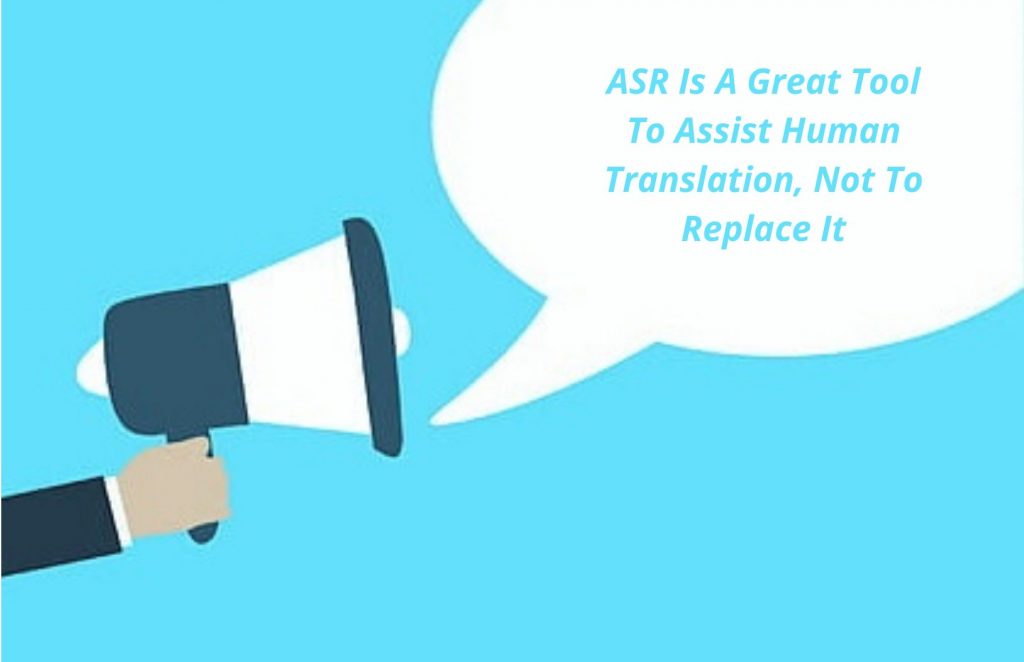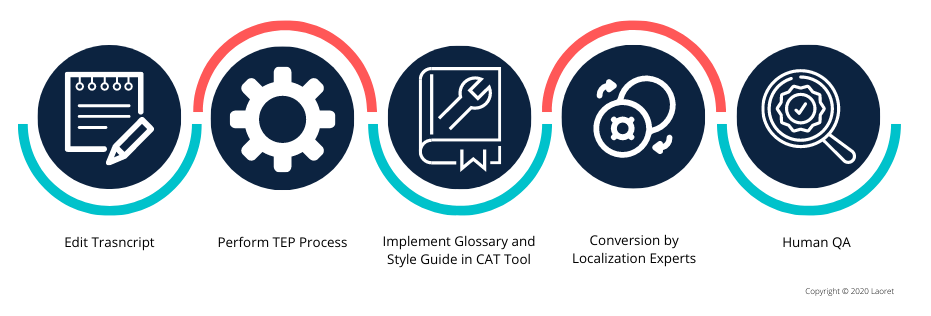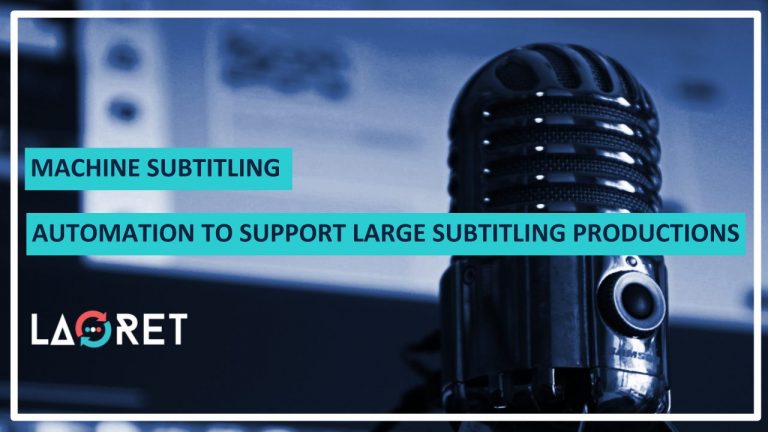Machine Subtitling: Automation To Support Large Subtitling Productions
Creating multimedia content and videos is on a constant rise. It has become essential for everyone operating in the digital space and across several industries including the media, games, and technology industries. Today, we will talk about how technology is evolving – more specifically for Machine Subtitling – and how this could be beneficial for those who are involved in huge subtitling productions and audiovisual translations.
Automation was designed to save time in an industry that is demanding high-quality delivery in the shortest possible TAT. With TV-Shows, online training courses, and video marketing tools bursting onto the scene eager to keep up with market demands, automation has been a welcome sight. And the professional linguists are here to fill in some of the holes left by machines and add human intuition and a genuine sense of connection.
Let’s explore the technological tools and methods implemented to conquer those market demands, and also have a closer look at the professionals they are supporting.
Automated Speech Recognition (ASR): Machine Subtitling’s Modern-Day Partner
When you hear the term ASR, you might instantly think about the automatically generated subtitles on YouTube. Depending on the audio quality and pronunciation of the narrator, the output can leave something to be desired. That being said, automation has been replacing certain parts of a job initially executed by humans exclusively, that includes Transcription and time-coding.
But, here is the important part that we like to stress as a Language Service Provider (LSP) dedicated to translation quality: not every part can be replaced by a machine, but with the right tools and workflow, it can be an effective support for the human Audiovisual Translation Professionals.
Let us expand on this a little.

Transcribing With ASR
Research has shown that even the most commercialized ASR Tools boost efficiency and productivity in subtitling. A typical manual transcription workflow starts from a division of the source file between multiple transcribers, adding not only in time but also hourly or page-per-rate wages. Saving time especially has become a prime mover behind automated revolutions and tools, where single audio or video file can be used to acquire a transcription within a fraction of that time.
However, we have to understand both the strengths and the limitations when working with ASR Software to speed up the process. You see, ASR is still far from perfect. You won’t receive a flawless product, but rather a time-coded draft ready to be submitted to a professional, human eye for the editing process prior to the translation.
A 2018 research paper 1 investigating the place of ASR in the translation workflow, pinpointed through various case studies that time can be saved and quality still maintained if the linguists are assigned to the source-text editing, translating, and revisions processes. A failure to attribute the human contribution to the wrong processes would compromise on both time and quality.
Pro Tip! Are you sure you understand the difference between Editing and Proofreading? Have a look at our blog detailing the responsibilities of editors and proofreaders, and know exactly which services to request!
Optimizing Your Recording For ASR
Let us give you a couple of tips. Because the human editing process will be helped along significantly if the ASR output is optimized. So, if you have any personal influence over the recording process, keep the following in mind:
- Use clear speech and articulation and avoid multiple speakers taking the floor at once. ASR Software has gotten pretty smart in recognizing the nuances of the human voice, but this can be hindered by poor quality recordings.
- Limit background noise so the voices stand out.
- Research top-notch ASR Software that would suit your goals best. Dragon Naturally Speaking, Microsoft Translate, and Webcaptioner, are popular examples.
- See what works best for your language. We might have good quality ASR tools for English Transcription but other languages like French and Italian, it is a little tricky. Not to mention a language like Amharic, for which you will probably not find a quality ASR tool. So, make sure to choose the right ASR that works best for the source language otherwise, it is best not to use them at all.
Did you know that by contributing the right info,
you can make subtitles cheaper for yourself?
Check out how!
Machine Subtitling Translation And Post-Production: Human QA
So, we have a time-stamp transcript acquired through ASR that has been edited by a linguist. Onto the translation. The human QA for the translation workflow is executed through the TEP (Translation, Editing, Proofreading) Process.

The use of Translation (CAT)/ Machine Subtitling Tools integrated with a glossary and Translation Memory (TM), can further automate the process by making use of a master list including technical jargon, brand-specific product names, and keywords, and a reusable terminology base. In order to preserve brand identity, a Style Guide should also be featured, listing the stylistic, structural, and linguistic preferences.
After the translation process is completed and any files that need conversion in specific Machine Subtitling output format(s), have been checked by the Localization/Audiovisual Experts, a rigorous quality check (QC) should be implemented to determine, among other aspects, if the subtitles are easy to read, perfectly timed, linguistically flawless and culturally potent.
Machine Subtitling And Machine Translation: Furthering The Automation Process?
What if we were to take the level of automation one step further and replace the ‘T’ in the TEP Process with another machine? Sure, it can be done. But not so fast. Let’s explore this topic further!
The Evolution Of Machine Translation Engines
The constant pressure of providing translations at a fast rate might make you wonder about Machine Translation (MT) as well as ASR. And yet, you may instantly ask yourself the question, do subtitles and MT actually work together? After all, subtitles aren’t dry, informational content like in most document translations. Instead, they are more conversational and informal.
Quick answer? Yes, MT-Engines can be used. Long answer? It needs to be done correctly. For this reason, MT-Engines used for Machine Subtitling should be:
- Specifically trained in dialogue so it can grow into a tool that can tackle more complex content and sentence structures over time
- Provided with an assembled version of the fragmented content (which is what subtitles essentially are) so the context can become a bit more clear
- Given correct sentence boundaries so the engines clearly know where the sentences begin and where they end
- Selected based on the language pair as well as the training capabilities
Pro Tip! Read our blog on Which MT-Engine suits your content and language pairs best!
Netflix Case study: How Should I Prepare My Content For Fast And Accurate Machine Subtitling?
MT isnt going anywhere. In fact, it has become obvious that it is finding its way into various industries where its suitability had previously been questioned. The Entertainment Giant Netflix had previously revealed that they use ASR to create English language templates in order to speed up the translation process. These days, however, they also shared a desire to break into the MT market and see what benefits could be reaped. Even more interestingly, they have published some findings into their methods.
The study 2 that outlining their motivations, uses a premise we also fully support when working with MT-Engines: Simplify and then translation. In our blog about the best MTPE practices, we have devoted a part of our guide to preparing your content for translation which focuses, among other things, on using clear and concise language as much as possible.
That is why Netflix has opted to experiment with the method of Back Translation. Going from the idea that translations are in themselves simpler than the source text, the study suggests running a Back Translation through the MT-Engine. The human translator has already simplified the idioms and cultural references to a more neutral text, and the newly acquired source text is now closer to a reusable model suited for multiple languages.
So you see, rather than shunning away from a much-debated Translation Method, it is more rewarding to actively experiment with ways to improve both MT-Engine output and User Experience, while still honoring increasingly rigid and demanding deadlines. And in this, highly trained linguists have their own job as well.

Post-Editing: How Human Intuition Matches Machine Speed
That’s right, even if the translation itself is provided by an engine, the Editing and Proofreading still have to be performed by a human linguist. Post-Editing, however, differs from the traditional editing process in that it requires a linguist with specialized knowledge of the engines that are used as well as the common challenges in working with them. Curious about which MT-Engine related challenges Post-Editors are trained to overcome? Here are a few:
- Each locale, language, and the client will have their own specific subtitle Style Guides and expectations when it comes to connecting with their audience, even in a more structural sense. Pauses, speaker changes, the acceptable reading speed of each language, will all need to be taken into account.
- The informal and altogether more personal nature of subtitles, means that cultural reference and colloquialisms are more freely used. This is why native linguists should be set the task to find appropriate alternatives that will have a similar effect on the target audience.
- Despite their complex evolution, MT-Engines are still not completely context-aware. Linguists are needed to prevent mistranslations based on misreading and varying grammatical structures.
Frequently Asked Questions
Are there still some questions left unanswered? Have a look at our FAQ section! Remember, our project managers are available around the clock to help you move ahead with your next subtitling project.
What is the best and fastest way to translate subtitles?
The best way to translate subtitles in a way that is both qualitative and efficient, is to find a balance between automation and expert linguists. While the transcription process can be automated and the Translation (CAT) Tools and TMS are equipped with customizable tools, a trained translator and localization engineer need to verify quality every step of the way.
How do I simplify subtitles for translation?
You can prepare your subtitles for translation by creating content with translation in mind and paying attention to minimizing the use of idioms and cultural references, using clear speech, limiting multiple speakers sharing the floor, and using straightforward language.
Is there a software to translate subtitles?
There are various subtitling software features on the market to choose from where subtitles can be added and edited, including options with automation tools. We would like to stress that when looking for top quality, especially with specialized or complicated content, human QA is required. Popular subtitle software includes YouTube, VEED, and Amara.
Conclusion:
Whether ASR, MT, or both are applied, any automation can only be used optimally in combination with native, in-country translators. Even with the quality of ASR and MT increasing constantly, the role of professional linguists remains crucial for anyone looking to connect with their target locale in a genuine way.
Laoret combines the most innovative tools on the market with a dedicated team of professional translators and localization engineers specialized in Multimedia Localization. Our services are available online, 24/7, and ensure a speedy delivery flawlessly delivered through our streamlined workflow and human QA.






